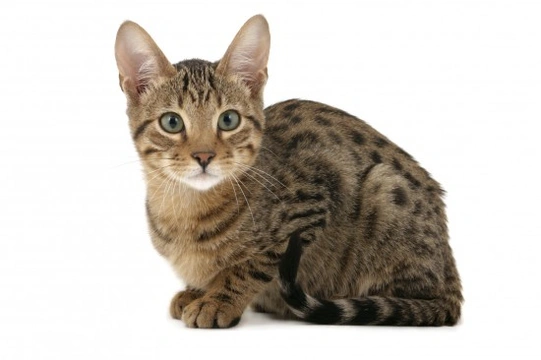
More information on the attractive and unusual Serengeti cat
The Serengeti cat is an unusual domestic cat breed that was produced by crossing the Bengal cat with the Oriental Shorthair. The intentions of producing the cat were to produce a domestic cat that resembled the wild serval cat, but without directly introducing any first-generation wild cat input into the breed lines. The Bengal cat itself is a hybrid breed, comprised of the crossing of domestic cats and wild leopard cats, so the Serengeti does possess wild cat ancestry, but not within any of their first generation crosses.
The Bengal cats used in the Serengeti breeding programmes are themselves several generations distant from their wild ancestors, and possess few, if any, traits of their wild relatives other than the coat colouration and patterning.
The Serengeti is a spotted cat that is very distinctive in appearance, with long legs and over large ears. They can weigh between eight and fifteen pounds, and males are larger than females. Due to the fact that the Bengal cat is classed as a hybrid cat, the Serengeti too is classified as a hybrid of wild and domestic cat heritage.
The Serengeti is appealing due to their sleek, beautifully patterned coats, and their larger than life personalities! However, like the Bengal, they can be challenging to own and are rather different to the average domestic moggy! If you are wondering if the Serengeti is the right cat for you, in this article we will address some of the most commonly asked questions about the breed as a whole. Read on to learn more.
Is the Serengeti cat a wild or semi-wild cat?
The Serengeti is classed as a domestic cat and not a wild or semi-wild cat, thanks to the genetic diversity present in both of the founding breeds. No wild cats were directly used as part of the Serengeti breeding programme, and even the very first cats used to breed the Serengeti were several generations removed from the Bengal’s wild ancestry.
The gene pool of the Bengal cat and the cats that helped to establish the breed is large and varied, and includes cats such as the British Shorthair, Asian Leopard cat, Ocicat, Indian Mau, Abyssinian, Bombay and Persian. The Oriental Shorthair side of their heritage includes the Siamese and the domestic shorthair, making the Serengeti a very genetically diverse cat.
However, wild cats were used to establish the first cats of the Bengal breed lines, and despite the fact that Bengals today are almost always many generations removed from their wild ancestors, this inclusion means that the Serengeti is a hybrid cat breed.
What do they look like?
The Serengeti is a large cat with long legs, roughly resembling the African serval only smaller, although as mentioned, no servals were directly used to create the breed. Their main defining feature is their large black spots, and their base colour can range from pale to gold underneath their patterning. Their coats are thick and short, and medium-soft. One colour trait seen in the Bengal cat, known as “glitter,” which adds a sparkly sheen to the coat, can also be seen in the Serengeti cat.
Another defining trait of the Serengeti cat is their very large ears, which are positioned right on the top of the head and should possess black backs and a central spot. The Serengeti’s eyes can range from gold to amber to green. The general build and size of the Serengeti is similar to the Oriental Shorthair, but rather larger with bigger bones, longer legs and bigger ears.
What is their temperament like?
The Serengeti cat is a bold, inquisitive feline that does not tend to be shy or nervous. They are self-confident, friendly and have open personalities, and like to be active. They are very adept climbers, and are equally happy scaling a tree or a set of curtains! They enjoy interactive play and having lots of toys and entertainment, and may make adept hunters.
They tend to get on well with other household cats providing that there is enough attention to go around, and also tend to get on well with dogs that are used to cats and do not chase them.
Are they recognised as pedigree cats?
The Serengeti cat is not recognised as yet by Britain’s GCCF (Governing Council of the Cat Fancy) and so cannot be registered as pedigree cats or entered into formal breed shows.
However, it is entirely likely that the breed may gain formal recognition in the future, particularly as the breed is already recognised by TICA (The International Cat Association) as a developing breed, which is one of the first steps towards gaining wider recognition.
There is already a set breed standard for the Serengeti cat and several breeders within the UK are working on producing ever improving breed lines, which may in the future form the basis of a new championship breed.



